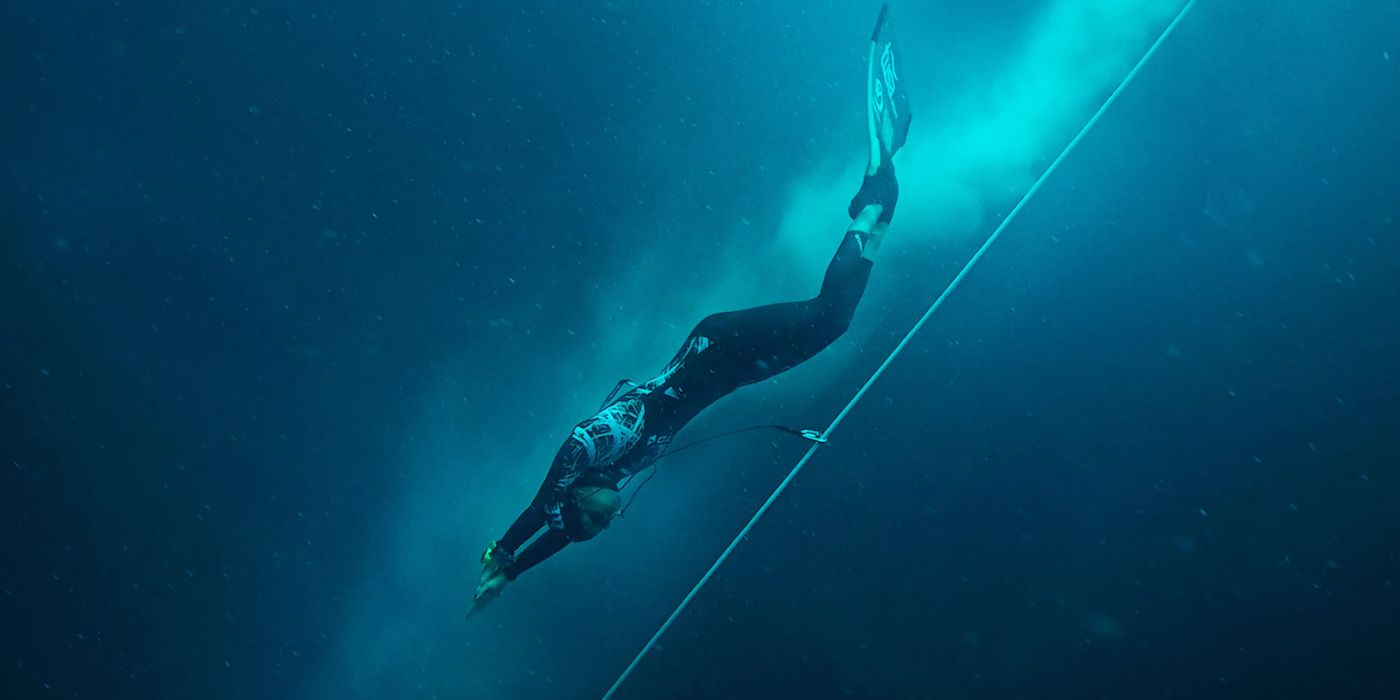The Big Picture
- Revealing too much at once can zap the suspense out of a documentary, as seen in
The Deepest Breath
on Netflix. - The film plays with audience expectations surrounding the survival of its main character, Alessia Zecchini.
- The documentary sensationalizes the deaths of its subjects, turning their well-being into a mystery that wasn’t necessary for recognizing the dangers of the sport.
How much should a documentary withhold from an audience? Revealing too much at once can either be confusing or zap the natural suspense out of the story being told. A documentary is different from a fictional movie, even one that claims to be “based on a true story” because it’s a true account of an event or individual. How it explores the story is still important, and it can be creative in ways other than using one interview after another, but when a filmmaker conceals key facts to progress a harrowing experience, it can feel too manipulated. The Deepest Breath on Netflix has an engaging story, yet the movie plays with audience expectations over the survival of its main character, free diver Alessia Zecchini. There is more genuine tension when the film is upfront and honest, rather than aiming for a gotcha moment, which is set up throughout.
The Deepest Breath
A champion and expert safety diver seemed destined for one another. Despite different paths taken, they meet at the pinnacle of the free-diving world, experiencing the thrilling rewards and inescapable risks of chasing dreams through the depths of the ocean.
- Release Date
- July 19, 2023
- Director
- Laura McGann
- Runtime
- 108 minutes
- Main Genre
- Documentary
What Is ‘The Deepest Breath’ About?
Competitive freediving involves descending into the depths of the ocean, holding in the air for the length they go. But The Deepest Breath is more than just the extreme sport it covers. At the center is Alessia Zecchini, an Italian world champion diver, and Stephen Keenan, a renowned Irish safety instructor. Together, they give a personal touch for audiences to invest in as freediving is examined. We see their upbringing and the unique ways they found the sport, building to a partnership and romance. But by the end, a diving site turns deadly. Stephen dies in an accident, and you realize how much this doc has been constructed to be a misdirection on Alessia’s fate.
The opening is on Zecchini as she’s asked “How do you feel about death?” We only hear audio of Alessia, and it’s not revealed when this recording took place. She responds simply that she isn’t afraid of it. What follows is a long take as she goes underwater for a competition in the Bahamas. Further and further down, she reaches the dark where the sunlight is absent. The takeaway is immediate. This is someone confident enough not to go into an unexpected panic and make a mistake.
On her ascent, Alessia slows down and suddenly blacks out, nearby safety divers pushing her the rest of the way up. At the surface, her body is limp and her eyes appear pallid, a horrifying scene that makes you worry about her safety — then the narrative jumps into the past. There is the feeling that something bad will occur with this framing device. The Deepest Breath does everything to keep in question what will happen to Alessia, not trusting how incredibly unique the story is.
Movie magic can invite audiences to head underwater, but this is the real deal. Seeing Alessia in competition is majestic before it hits you with the risks to the sport. While safety is carefully practiced, blackouts occur. To lead up to when Alessia suffers from this condition, there is extensive archival footage, reconstructed shots, and sit-down chats with family and friends. During the interviews with Stephen and Alessia’s fathers, they appear withdrawn, with a distinct melancholic quality of Alessia’s father. When he recalls happier memories, it’s as if they are clouded by sadness. It isn’t hard to get the impression something has happened to his daughter.
‘The Deepest Breath’ Keeps Alessia Zecchini’s Fate a Mystery
Most notably, Stephen and Alessia are only seen in archival footage, and while they are heard in voice-overs, it’s not established how recent the audio is. The interviews and the audio recordings then explore who these two individuals are. Alessia was a determined teen who knew she wanted to become a free diver and trained fiercely for it. Stephen, on the other hand, wandered into the sport. He was endlessly curious growing up and loved to travel, and a passion for diving introduced him to freediving. The interviewed family and friends refer to them in the past tense, and this makes sense. They’re remembering older experiences, but there’s an extra layer to this.
Director Laura McGann wanted to keep viewers in the dark about the story’s ending, saying to NPR, “You don’t know anything that the people on the screen don’t know.” This approach ultimately sensationalizes the real human loss that is Stephen’s death, turning the wellbeing of Alessia and Stephen into a mystery that isn’t necessary to recognize the danger of the sport. It’s made very clear, freediving is a competition in which divers will push themselves. When Stephen has a severe blackout, the frightening incident leads him to become a safety diver to protect others from what happened to him. Even in a new position, the sport is unpredictable. He swims a far distance underwater than he has enough air for, to help diver Alexey Molchanov, who slips into a blackout. These moments highlight the risks, as well as two freedivers who lost their lives.
‘The Deepest Breath’ Focuses on the Dangers of Freediving
In an audio recording, Alessia tells us, “Natalia Molchanova is my greatest idol.” Molchanova, mother to Alexey, was a world-champion Russian freediver, who had the record of holding her breath for nine minutes and two seconds. In 2015, Natalia went missing during a private lesson in the water. Her body wasn’t found, and this death brought substantial awareness to Alessia. Before that, she stated she didn’t put much thought into death. In a voiceover, she admits, “After Natalia’s accident, I began to realize that it could be dangerous.”
It brings awareness to the movie’s audience too. If a champion like Natalia could lose her life in an accident, what could that mean for Alessia? After pushing himself too hard, Stephen realized he had to be safer, but Alessia hadn’t figured out her limits as a competitive diver. Natalia isn’t the only death brought up, there is also Nick Mevoli who died during the Vertical Blue competition. “You don’t know what dive is gonna be your last,” the free diver says in an archival clip used as an eerie premonition.
While he surfaced from his dive, he suffered a fatal lung squeeze due to the ocean depth’s pressure. Vertical Blue is an important location in the documentary. This is where Alessia has her blackout and the film is finally catching up to where it opened. Not only do we see that she does survive, but her blackout is treated as nothing more than a setback. To beat a competitor’s 104-meter record, Alessia descends, while the footage remains above the water where the safety divers and judges are. The minutes that follow with no sign of Alessia are excruciating.
While no one appears uneasy, it’s what is not said that creates such a tense atmosphere. But like with her earlier blackout, she makes it out okay. Finally, she swims up and beats the record. Her stubborn personality is a talking point for those who know her, it’s what pushes her to be a stronger diver, but the fatalities mentioned stir up concern. Her idol and a fellow diver died, one outside competition and the other during, implying Alessia could face an incident that won’t be just another setback.

The Best Documentaries on Netflix Right Now
Let’s get real.
Stephen’s Death Is Treated as a Plot Twist Rather Than the Tragedy It Is
Around this time, Alessia and Stephen meet. He brings out the best in her, helping her gain a stronger discipline in how she holds in oxygen. The two become a couple, with photos showing how inseparable they are. Not long after, they prepare for the next dive at the Blue Hole in Dahab, Egypt. It’s an infamous place “even more perilous than Mount Everest,” where a diver must go 52 meters down, swim 30 meters horizontally to enter an arch, and then swim back up. Alessia goes for a practice round, which goes wrong. The suspense over each previous dive has been stretching out for so long, that this is when it finally snaps.
Deep underwater, Stephen tries to locate her, but they miss each other by 30 seconds. After Stephen finds her, the air they’re holding in is dangerously running out. They both suffer from blackouts and while Stephen helps keep Alessia face up at the surface, he rises face down, drowning as a result. Ascension is the most hazardous moment for the sport due to strained oxygen, emphasized in the opening of the documentary. Stephen’s death is treated as a belated plot twist, since for most of the runtime, there is a prevalent sense that something bad will happen to Alessia.
‘The Deepest Breath’ Turns Tragedy Into a Plot Twist
Editor Julian Hart talked to Filmmaker Magazine about putting the movie together, stating, “As a retrospective story we always knew our endpoint, a free dive off Egypt’s Red Sea coast in 2017.” Knowing this, Hart explained how he “turned to the beginning. We wanted the audience to understand the stakes and difficulties of free diving. The opening frames Alessia’s thoughts about the risks of her sport in relation to a competition dive.” Alessia is significant to the documentary, evident in how she’s introduced and her role in competitions. Yet, her only in-person interview comes at the last ten minutes, confirming the diver who died wasn’t who the audience was purposely meant to think it would be.
“I try to remember his hugs. He’s the person who taught me what it’s really like to hug someone,” Alessia says. It’s a heartbreaking statement, but one that didn’t need hiding her survival to be as emotional as it is. Family and friends react differently while talking about Stephen’s passing, all of it upsetting to hear. There’s a rawness to Alessia’s father, who admits he wishes he could have swapped out his life for Stephen, clarifying why there was such sadness to his interviews. How the doc suddenly brings Alessia in and treats Stephen’s death as a shocker is a misguided bait-and-switch to the movie’s key relationship. Like how Stephen saved Natalia’s son, Alexey, he did the same in rescuing Alessia, selflessly putting her life before his own. It’s a tragic end already. It didn’t need to be made into a plot twist.
It’s a delicate balance on how much a documentary should reveal, but The Deepest Breath didn’t need to hold back on what happened to its subjects to strengthen the narrative. These are real people talking about their own freediving experiences, and that should be enough to bring in suspense and overall audience engagement. There is truly beautiful footage of free divers as they float in a blue void, bringing you closer to what freedivers must feel like in their world. The visuals, the tragic stories of other divers, and Stephen’s death are powerful enough because of the first-hand accounts involved in revisiting them. While The Deepest Breath on Netflix will give you plenty of anxiety, the ending twist feels unnecessary, something it didn’t need to pull you under while exploring this extreme sport.
The Deepest Breath is streaming on Netflix in the U.S.
Watch on Netflix
Source link

